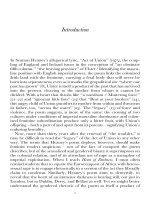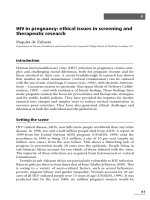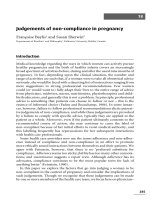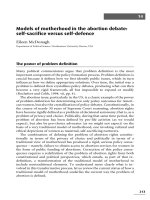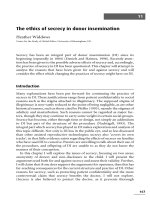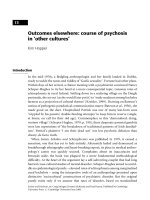Judgements of non-compliance in pregnancy
Bạn đang xem bản rút gọn của tài liệu. Xem và tải ngay bản đầy đủ của tài liệu tại đây (185.83 KB, 20 trang )
18
Judgements of non-compliance in pregnancy
Franc¸oise Baylis
1
and Susan Sherwin
2
Departments of Bioethics
1
and Philosophy
2
, Dalhousie University, Halifax, Canada
Introduction
Medical knowledge regarding the ways in which women can actively pursue
healthy pregnancies and the birth of healthy infants covers an increasingly
broad spectrum of activities before, during and after the usual nine months of
pregnancy. In fact, depending upon the clinical situation, the number and
range of activities are such that, if a woman were to take all obstetrical advice
seriously, she would be faced with a daunting list of instructions ranging from
mere suggestions to strong professional recommendations. Few women
could (or would want to) fully adapt their lives to the entire range of advice
from physicians, midwives, nurses, nutritionists, physiotherapists and child-
birth educators, and generally this is not a problem. In principle, professional
advice is something that patients can choose to follow or not – this is the
essence of informed choice (Faden and Beauchamp, 1986). In some instan-
ces, however, failure to follow professional recommendations elicits pejorat-
ive judgements of non-compliance, and while these judgements are provoked
by a failure to comply with speciWc advice, typically they are applied to the
patient as a whole. Moreover, even if the patient ultimately consents to the
recommended course of action, she may continue to carry the label of
non-compliant because of her initial eVorts to resist medical authority, and
this labelling frequently has repercussions for her subsequent interactions
with health care professionals.
Some health care providers now use the terms adherence and non-adher-
ence instead of compliance and non-compliance in an eVort to promote
more ethically sound interactions between themselves and their patients. We
agree with Feinstein, however, that there is no ‘preferred substitute for
compliance. Adherence seems too sticky; Wdelity has too many other connota-
tions; and maintenance suggests a repair crew. Although adherence has its
advocates, compliance continues to be the most popular term for lack of
anything better’ (Feinstein, 1990).
In this paper we explore the factors that go into judging a woman to be
non-compliant in the context of pregnancy and consider the implications of
such judgements. Though we recognize that these judgements can be made
by one or more members of the health care team, we focus here on physician–
285
patient interactions. We are particularly interested in understanding what
is problematic in the circumstances that elicit judgements of patient non-
compliance from the perspectives of both the physician and the patient.
Towards that end, we explore a number of scenarios in which these judge-
ments may arise and try to understand the reasons for the patient’s behaviour
and for the physician’s decision to apply that label. Further, we consider the
implications for the patient–physician relationship of invoking a framework
that evaluates patient behaviours and choices in terms of compliance and
non-compliance. Finally, we suggest that a subset of the behaviours and
choices that the language of non-compliance now captures are not inherently
problematic. They ought not to be construed as non-compliance, but rather
as informed or uninformed refusals. In our view, the only situations that are
inherently problematic are those where the patient fails to comply with her
own choices which may or may not be consistent with directions from her
physician. A commitment to provide respectful health care requires that
these situations be dealt with in a way that enhances, rather than undermines,
autonomy-respecting, integrity-preserving patient–physician interactions.
The scope of compliance/non-compliance judgements
To situate the experience of women who are judged to be non-compliant
with respect to obstetrical advice, we review the range of advice that women
are likely to receive before, during and after pregnancy.
The advice
Medical advice about pregnancy and pregnancy-related behaviours begins
before conception. There are medical opinions on who should become
pregnant, when and under what circumstances. For example, women diag-
nosed with a serious medical condition that makes pregnancy extremely
hazardous for themselves and/or their fetuses (e.g. cyanotic heart disease,
brittle diabetes or AIDS) are among those who may be advised not to become
pregnant. Frequently these women require medication to control their own
illnesses, and in some cases their doctors worry that these medications may
have an adverse eVect on the developing fetus. Of equal concern are the
health risks to the women should they decide to stop or alter their medica-
tions during pregnancy. Particularly troublesome in this regard are cases of
mental illness such as schizophrenia or depression where women’s ability to
function in society is thought to be dependent upon continued use of the
prescribed medication. In such circumstances, women who choose to be-
come pregnant against medical advice are faced with the unpalatable choice
286 F. Baylis and S. Sherwin
of continuing their medication and risking the well-being of their future
child, or abstaining from its use for the duration of the pregnancy and
seriously risking their own health and independence.
For women who intend to become pregnant, there is also advice on the
timing of conception. From a medical point of view, it is best to bear children
in early adulthood (from late teens to early thirties). Pregnancy too late in a
woman’s life can increase the health risks to both the woman and the fetus.
For example, women over 40 years of age face an increased rate of gestational
diabetes and hypertension as well as an increased rate of fetal chromosomal
anomalies. Further, in some cases there will be patient-speciWc advice regard-
ing the timing of conception because of the woman’s particular health status
and needs. For example, a woman with severe cervical dysplasia could be
advised to delay pregnancy until her treatment was complete. Sometimes
advice about the timing of conception is followed, sometimes not; and
sometimes this is intentional, sometimes not.
In addition to the above, there is medical advice about a range of pre-
conception behaviours that may aVect the medical outcome of pregnancy.
For example, in the months before pregnancy it is important to eat a
well-balanced diet and take folic acid supplements to reduce the risk of spina
biWda and other neural tube defects. For this reason, family doctors and
gynaecologists post notices in their oYces directing women to consult them if
they are ‘thinking about becoming pregnant in the next few months.’ Despite
extensive eVorts to educate fertile women about the beneWts of pre-concep-
tual folic acid however, many remain unaware of these beneWts. And among
those who are aware of the beneWts of folic acid supplementation there is still
a high rate of incorrect usage (Metson et al., 1995; Roberts, 1996).
Further, before pregnancy is initiated women will be advised to overcome
addictions to such dangerous substances as tobacco, crack cocaine, anabolic
steroids and solvents. From a medical perspective this advice is hardly
optional. From the woman’s perspective this advice, though sound, may be
impossible to follow; addictions are not simply about choice (Baylis, 1998).
Unfortunately, some physicians seem to have little appreciation for the
powers of addictions and become very angry with women who expose their
fetuses to harm for the sake of a smoke or a high. (For further discussion see
Chapter 8 by Susan Bewley.)
Once women do become pregnant, they are enjoined to become patients
and the medical advice they receive typically becomes more direct and
potentially overwhelming. Prenatal care usually includes advice on virtually
all aspects of a woman’s life, including:
∑ diet (eat plenty of green, leafy vegetables, consume lots of calcium, monitor
weight gain);
∑ exercise (do this in moderation, with some activities curtailed);
287Judgements of non-compliance in pregnancy
∑ work, including unpaid housework (avoid exposure to dangerous chemi-
cals, heavy lifting; reduce hours and stress; in certain circumstances, give
up work altogether and remain conWned to bed);
∑ prescription and over-the-counter drugs (avoid most, take care with
others);
∑ tobacco (stop smoking and also avoid second-hand smoke)
∑ alcohol (avoid drinking)
∑ recreational drugs (stop);
∑ sex (continue as comfortable).
Further, women with pre-existing medical conditions that make pregnancy
particularly hazardous, and those who develop serious conditions such as
hypertension in the course of pregnancy, will receive much more urgent and
case-speciWc instructions. With due diligence, but varying degrees of success,
most women will try to follow these directives. Among those who fail, some
will be labelled non-compliant.
Also, during pregnancy women are likely to be given advice regarding
genetic counselling and testing, particularly if their pregnancy results from
the use of reproductive technologies, or if they are considered at above
average risk of giving birth to a child with a serious disease or disorder. This
latter category includes women of ‘advanced maternal age’, women with a
family history of genetic disease, and women who are members of an at-risk
community (e.g. elevated risk of Tay–Sachs disease among Ashkenazi-de-
rived communities). If a woman follows such advice and certain fetal
anomalies are detected, or the woman is found to be carrying multiple
embryos, more advice will likely be forthcoming (claims about non-directive
counselling, notwithstanding). In some cases, the woman may be advised to
terminate her pregnancy or undergo selective fetal reduction. In other cases,
as when the fetus has a major congenital anomaly that could be corrected in
utero, she may be encouraged to consent to fetal therapy or research
(Caniano and Baylis, 1999). Not surprisingly, women’s responses to such
advice varies considerably.
Doctors also have Wrm opinions about the best ways of managing the
potentially complicated and dangerous Wnal stages of pregnancy – labour and
delivery. The timing, mode and location of delivery are all subject to strong
medical advice and are frequently the source of serious contests of will
between patients and their doctors. For example, it is not uncommon for
some women to question their doctors about the wisdom of initiating and
continuing tocolysis for preterm labour or inducing labour for worsening
gestational hypertension (Lettrie et al., 1993). There can also be serious
disagreement regarding the need for Caesarean section, anaesthetic, episi-
otomy or forceps, as well as disagreement about the participants to be
involved in the delivery including the roles of midwife, labour coach and
288 F. Baylis and S. Sherwin
children. A patient’s resistance to medical preferences on such matters may
be interpreted as non-compliance on the part of worried and exasperated
physicians.
The location of delivery can also be a contentious issue. In North America,
particularly, doctors tend to be wary of home births. Further, depending
upon the circumstances of the pregnancy, physicians may want to insist that
women travel to a tertiary care centre fully equipped with all necessary
technology. For women in remote rural areas, these demands can be especial-
ly burdensome.
Finally, medical care does not end after women have given birth. The
postpartum woman will be advised to return to her family physician for
follow-up care to make sure that her uterus has involuted (returned to
normal size), there are no infections or cervical abnormalities (pap smear),
blood pressure has returned to normal, nutritional status is adequate, and so
on. At this time, the woman will receive advice about the appropriate period
of time to wait before becoming pregnant again and options for contracep-
tion. There will also be questions about, and advice relevant to, the mother–
child relationship, nursing, coping and general fatigue. As well, the new-
born(s) will be monitored to ensure adequate nutrition and appropriate
growth. The general expectation is that ‘good’ mothers will comply with
physician advice on how best to promote their own and their child’s health
and well-being.
Implications of the compliance and non-compliance
framework
As the above clearly shows, there is an overwhelming amount of expert
medical advice directed at women who are contemplating pregnancy or are
currently pregnant. Moreover, this advice is layered on top of abundant
general health advice (e.g. about good oral health, breast self-examinations,
stress management and so on), as well as advice about proper care of existing
children, households and partners. Few women will manage to follow all of
this advice and most will diverge at least to some degree from the directions
they are oVered. Happily, most women none the less will emerge from
pregnancy with their own health and that of their fetuses intact. Moreover,
many will escape the label of non-compliant. It is worth observing, then,
when physicians evaluate failure to act in accordance with medical advice in
terms of the compliance and non-compliance framework, and when they do
not.
It appears that judgements of compliance and non-compliance are re-
served for circumstances in which there exists a physician–patient relation-
ship or formal interaction. Since most healthy fertile women do not assume
289Judgements of non-compliance in pregnancy
the role of obstetrical patient until they are pregnant and seeking routine
prenatal care, it is unusual for these labels to be invoked (with respect to
reproduction-related behaviours) prior to conception. Physicians may worry
about women who conceive outside of the ideal time frame, eat inadequate
diets, or consume dangerous substances – and some will make disapproving
moral judgements regarding those who Xagrantly ignore widely available
medical knowledge – but most doctors are unlikely to label such women
non-compliant. Failure to act in accordance with general directives for
initiating a healthy pregnancy may be regretted, and may even be construed
as evidence of poor judgement, but such failure is unlikely to be perceived as
non-compliance. It is quite a diVerent matter, however, when the women are
in the speciWc role of patient ‘under the care of’ a physician (or clinic), where
failure to comply involves the rejection of patient-speciWc medical advice.
None the less, not all divergence from physician opinion will evoke the
label non-compliant. For example, the term is seldom used when the behav-
iour in question is within a morally contested realm such as prenatal genetic
testing. In the face of public and professional debates about the appropriate-
ness of the genetics agenda, refusal of genetic testing is generally tolerated.
Also, the label non-compliant is seldom used when patients demonstrate
excessive enthusiasm for medical interventions deemed unnecessary. For
example, patients who request Caesarean deliveries that their doctors do not
consider medically required may have their requests refused, but they are
unlikely to be seen as non-compliant. (See Chapter 17.) The same is true with
patients who request/demand an amniocentesis in the absence of profes-
sionally accepted risk factors. Thus, it appears that failure to act in accord-
ance with patient-speciWc medical advice is a necessary but not a suYcient
condition for being so labelled.
The label non-compliant is readily assigned, however, in cases where there
is a perceived risk of serious harm for the fetus or the woman that is avoidable
but for the woman’s failure to comply with her physician’s recommenda-
tions. The paradigm of non-compliance is women who continue to smoke or
drink (or sniV solvents, use crack cocaine or other illegal drugs) during
pregnancy, and women who do not defer to medical expertise during labour
and delivery (Greenwall, 1990; Lescale et al., 1996).
Some clear patterns emerge regarding judgements of compliance and non-
compliance. First, these judgements not only denote the existence of a
doctor–patient (or health care professional–patient) relationship (or formal
interaction), they also reXect certain assumptions about the nature of that
relationship. SpeciWcally, the framework of patient compliance and non-
compliance expresses a commitment to an implicit hierarchical structure
within medicine, in that these terms reXect an understanding of the doctor–
patient relationship as inherently unequal. The labels compliant and non-
compliant apply in cases where those with greater power have issued
290 F. Baylis and S. Sherwin
directives to those with less power, and these directives have either been
followed or set aside. In marked contrast, those with lesser power can only
make requests of those with greater authority. For example, patients who
refuse to act in accordance with physicians’ professional recommendations
can be deemed non-compliant with medical advice. On the other hand,
physicians who refuse to act in accordance with women’s requests may be
judged uncooperative, but not non-compliant. To be sure, it is possible for
physicians to be labelled non-compliant, but in their case it is not for failure
to respond to patients’ demands, but rather for failure to comply with
practice norms or professional guidelines, such as established protocols,
prescription standards or research criteria. (See, for example, Cheon-Lee and
Amstey, 1998; Helfgott et al., 1998.)
Furthermore, within the doctor–patient relationship the label non-com-
pliant does not simply record the patient’s divergence from prescribed
behaviours, it also expresses/implies disapproval of, and disappointment in,
the patient’s behaviour. When the label is invoked, there is a presumption
that something has gone seriously wrong in the relationship and that blame
should be assigned. Physicians applying the label non-compliant generally
intend to assign that blame to patients, particularly when patients refuse
interventions that are standard care. From the physician’s perspective such
refusals not only represent needless risks with the future well-being of the
patient and/or her oVspring, but they also create potential problems of legal
liability in the event of a ‘bad outcome’ and a later claim by the patient about
inadequate care. Not surprisingly, physicians may seek to distance themselves
from such responsibility.
Interestingly, however, much of the literature tracking this phenomenon
suggests that blame for patient non-compliance should rest with physicians
and not patients, since it is the responsibility of the former to inform properly
and educate patients and, in so doing, to convey adequately the importance
of conscientiously following medical advice (DiMatteo and DiNicola, 1982:
esp. p. 251). Jonsen, for example, argues that ‘[t]o refer to the problem as
compliance is to pose it as a problem of the behavior of patients and,
consequently, to seek its causes in the patient. In so doing, the sins of the
careless, irrational, authoritarian physician are visited on the heads of his
patients’ (Jonsen, 1979). Issues of blame and responsibility aside, there are
good reasons to question the labelling of patients as non-compliant. Labell-
ing particular patients in this way emphasizes the authoritarian nature of the
physician–patient relationship without usually producing ‘better’ patient
behaviour.
In addition, situating patient behaviours within a framework of compli-
ance and non-compliance discourages development of the trust that is
essential for a good doctor–patient relationship. In labelling a patient non-
compliant, the physician is expressing his/her distrust in the patient’s ability
291Judgements of non-compliance in pregnancy
or motivation to make appropriate use of medical expertise. The term is
pejorative and often functions as an expression of exasperation at the pa-
tient’s ‘irresponsible’ behaviour. For her part, the patient may be sensitive to
any moral judgements surrounding her behaviour. She may be wary of
negative labels generally and, in particular, worried about being labelled
non-compliant and abandoned by her physician if she is judged unworthy.
Hence, she may feel anxious about being fully honest with her physician.
Rather than bringing her questions and concerns to the forefront, she may tell
the physician what she thinks he/she wants to hear and may also seek to
minimize the time spent with her physician in order to hide her ‘negative’
behaviour and avoid disapproving lectures.
Finally, the decision to invoke the framework of compliance and non-
compliance works against the goals of informed choice. It does not situate the
woman’s actions and choices in the context of her own life, but instead
constructs and evaluates the patient’s behaviour in response to her phys-
ician’s expressed views regarding the means necessary to achieve a ‘good
outcome’. The woman’s agency is reduced in that she is discouraged from
determining her behaviour on the basis of her own perception of what
constitutes a good outcome and how best to achieve it. She is expected to
follow passively medical instructions or to Wnd herself on the defensive,
accounting for her failure to do so. This situation, where consent is de
rigueur, is clearly at odds with the professed commitment to respect the
autonomous choices (i.e. informed consents and informed refusals) of pa-
tients.
In sum, the framework of compliance and non-compliance trades on the
unequal, hierarchical nature of the physician–patient relationship, poten-
tially denigrates patients, undermines trust, reduces patient agency, and
conXicts with the goals of informed choice. Given these problematic implica-
tions, it is curious that this framework is so prominent in obstetrics and other
areas of medicine.
A closer look at judgements of non-compliance
While there is wide variation among physicians in the appropriate use of the
term non-compliant, in general a physician will label a pregnant woman
non-compliant when she fails to act in accordance with expressed medical
advice that is believed to be of beneWt to herself or her fetus. The physician
worries that the woman’s behaviour unnecessarily increases the risk of
avoidable harm. In addition, other factors sometimes inXuence the phys-
ician’s decision to apply the label non-compliant. For example, some phys-
icians are personally aVronted by their patients’ unwillingness to follow their
advice; they interpret such action as evidence that the patient lacks respect for
292 F. Baylis and S. Sherwin


